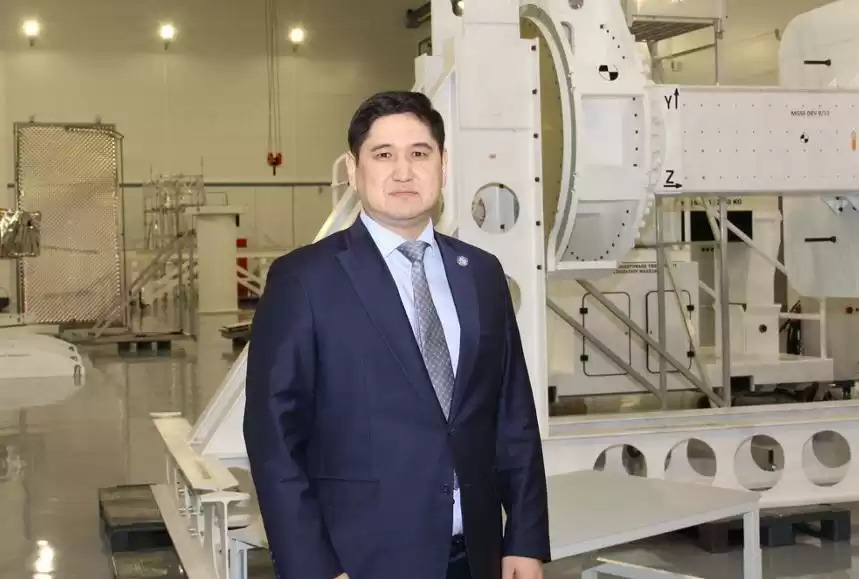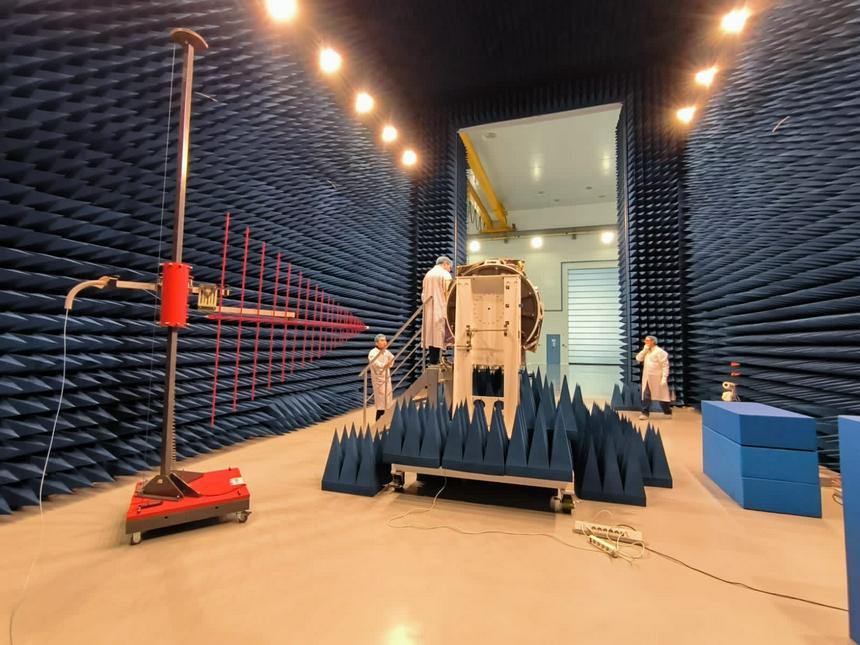ASTANA – On April 12, 1961, the Soviet Vostok-1 spacecraft took off from the Baikonur Cosmodrome in Kazakhstan with Yuri Gagarin on board, making him the first human to travel into space. Since then, April 12 has been celebrated as Cosmonautics Day throughout the world.

Baubek Oralmagambetov. Photo credit: inform.kz.
Kazakhstan has been at the forefront of space exploration. Baubek Oralmagambetov, chairman of the Aerospace Committee of the Ministry of Digital Development, Innovations and Aerospace Industry, spoke with Kazinform about Kazakhstan’s space industry and future ambitions.
Can you tell us about the space infrastructure of Kazakhstan?
The development of the country’s space activities is carried out in five areas that are interconnected, interdependent, and consistently developing. It is this process of integrated space activities and the sustainable development of all areas that enables us to discuss the country’s space industry.

Photo credit: inform.kz.
The first area is scientific space research – fundamental and applied. Space research starts with science. In our case, it is being conducted by the Fesenkov Astrophysical Institute and the Institute of Ionosphere, which study far and near space, solar-terrestrial relations, within which unique cosmological objects of the Universe are monitored. In addition, they try to solve problems of modeling large astronomical systems and establish a method for diagnosing and predicting the state of space around Earth.
Our organizations also conduct applied research, including developing satellite technologies, creating instruments and developing systems for monitoring near-Earth space. These are critical technologies to increase Kazakhstan’s contribution to the satellite industry and develop Kazakh engineers’ skills and competencies.
The second area is the production of space equipment, which entails building spacecraft in the context of applied scientific developments. The Spacecraft Assembling and Testing Facility was launched at the National Space Center on March 30. It is intended to design, manufacture, assemble, and test satellites weighing 100 kilograms to six tons. The complex has five production and six test sites and three laboratories.
The work of the organization, including the competence of its specialists, is certified by its international partner Airbus, which will enable it to attract international orders in the future.
Are Kazakh specialists ready to operate this unique space complex?
We have all the skills to operate such a high-tech complex. Our engineers have received training at European production sites with English and French engineers. As a result, a joint team led by Kazakh engineers implemented a project in 2018 to create a technological space system called Kazakhstan Scientific and Technological Satellite (KazSTSat), which incorporates five new technologies. This satellite has been in orbit for five years, and we expect it to carry on for at least seven years.

Photo credit: inform.kz.
This year, we expect an order to design KazEOSat-MR, a Medium Resolution Earth Observation Satellite (ERS) consisting of at least three spacecraft. Kazakh engineers have good experience and technologies previously obtained as part of creating the KazSTSat satellite.
Kazakhstan is fully involved in the assembly and tests of satellites at the Spacecraft Assembling and Testing Facility. We are 50 percent ready to design satellites for remote sensing of the Earth; however, no more than 10 percent in terms of the design of telecommunication satellites.
The third direction is providing launch services. Kazakhstan has the world’s first and largest cosmodrome – Baikonur – leased by Russia until 2050. Despite the lease, Kazakhstan owns the Zenit space rocket system, withdrawn from the lease in 2018 to modernize it as part of the Baiterek project between Kazakhstan and Russia. The Kazakh side is responsible for the modernization of the ground launch, while the Russian side creates an environmentally friendly Soyuz-5 launch vehicle.
This project enables Kazakh technical specialists to improve their skills while working with design documentation and operating and maintaining the Zenit space rocket complex, which local specialists fully service.
The fourth area is the operation of spacecraft and ground control systems. This includes three satellite systems of Kazakhstan, consisting of five spacecraft – KazSat-2 and KazSat-3 communication and broadcasting satellites and their backup control complexes – Akkol and Kokterek space communication centers. The National Center for Space Communications operates the KazSat space communication system.
Kazakhstan Gharysh Sapary national company operates two KazEOSat-1 and KazsEOSat-2 Earth remote sensing satellites, while Ghalam operates KazSTSat technology satellites. Kazakh design engineers took part in assembling this space equipment.
Finally, the fifth direction is space technology services.
What is the economic impact of space technology?
The provision of space communications services is one example. KazSat-2 and KazSat-3 communication satellites fully meet the country’s demand for communication services, television, and radio broadcasting. It contributes significantly to the country’s economy and also ensures the information independence of the state. The National Center for Space Communications was instructed to provide internet to remote villages. Last year, the project was implemented in ten villages. This year, another 176 villages in Kazakhstan’s regions will be provided with the internet.

Photo credit: inform.kz.
Kazakhstan’s ERS satellites carry out space surveys, monitoring the changes in natural and anthropogenic processes. Kazakhstan Gharysh Sapary delivers 40 services for industry government agencies.
Kazakhstan has improved the use of these technologies, which at the first stage provided only space images. Later, they offered analysis and interpretation of space images, and now they provide access to the business processes of government agencies, ensuring public services online. A striking example is the website for subsoil users, minerals.gov.kz, where companies can apply for a license to extract and explore solid minerals.
In the future, this approach can be used for other industries, with a complete digitization of data and connection to the business processes of government agencies.
Another example is the JerInSpectr platform, designed to monitor the rational use of land with the help of ERS data.
I would also like to mention the commercialization of scientific projects, which became possible thanks to the Kazakh scientists’ developments in information space technologies. They include an emergency call system for accidents and catastrophes (EVAC) and the Transit navigation system with electronic seals on heavy vehicles, which are being developed now. Ultimately, space technologies make an excellent contribution to the country’s economy.
How can you describe people working in the space industry?
Gharysh Sapary employs many young engineers and scientists, who improve the management of satellites, develop space technology, and deal with complex tasks of introducing space technologies in various sectors of the economy.

Photo credit: inform.kz.
The Kazakh space industry is an intertwined, mutually supporting ecosystem based on people and their skills. These people are always ready for new discoveries and tirelessly improve their knowledge and experience to solve complex problems.
Have you ever dreamed of becoming an astronaut?
I dreamed of becoming a design engineer and was lucky to get this opportunity and work as a design engineer. One of my tasks is to preserve and increase the number of our space equipment: ERS satellites and communications and broadcasting satellites. We should develop it with our technologies and with the participation of Kazakh specialists. In addition, our task is to expand services based on space technology.
The article was originally published in Kazinform.


